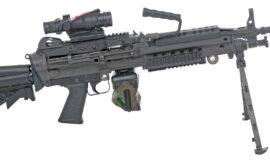The Heckler & Koch G3 is a battle rifle that has earned a reputation for reliability, robustness, and widespread use across the globe since its introduction in the late 1950s. Developed in West Germany, it became one of the most successful military rifles of the Cold War era and beyond, serving numerous armed forces and seeing action in various conflicts. Here’s an overview of its history, design features, military use, and legacy:
Historical Background
The development of the G3 began in the late 1950s at Heckler & Koch (H&K), based on their previous work with the Spanish CETME rifle (Centro de Estudios Técnicos de Materiales Especiales). The G3 was designed to meet the requirements of the Bundeswehr (West German Army) as they sought to replace their World War II-era Mauser Karabiner 98k rifles with a more modern and capable firearm.
Design and Features
The Heckler & Koch G3 incorporates several key design features:
- Roller-Delayed Blowback Operation: The G3 operates on a roller-delayed blowback system, where rollers delay the rearward movement of the bolt during firing, enhancing reliability and allowing for a relatively lightweight bolt assembly.
- Chambering: It is chambered in 7.62×51mm NATO, a powerful cartridge with good long-range performance and stopping power.
- Stamped Steel Receiver: The rifle’s receiver is made from stamped steel, which contributes to its durability and robustness while keeping weight manageable.
- Rugged and Simple Construction: The G3 is known for its rugged construction and simplicity, making it reliable in adverse conditions and requiring minimal maintenance.
- Telescoping Bolt: The bolt assembly of the G3 features a telescoping design, where the bolt head extends over the breech end of the barrel, aiding in accuracy and reliability.
- Adjustable Sights: It is equipped with adjustable iron sights for precise aiming at different distances.
Military Use
The Heckler & Koch G3 has been widely used by various armed forces and security forces around the world:
- West Germany and NATO Allies: Adopted by the Bundeswehr in the late 1950s, the G3 became the standard-issue rifle and saw widespread use among NATO countries during the Cold War.
- Global Adoption: Beyond NATO, the G3 was adopted by numerous countries in Europe, Africa, Asia, and Latin America due to its reliability, robustness, and effectiveness in combat.
- Conflicts and Deployments: The G3 has seen action in conflicts such as the Cold War proxy wars, Middle Eastern conflicts, and various peacekeeping missions.
Variants
The G3 has several variants and derivatives tailored for different roles and user preferences:
- G3A3: Standard infantry rifle variant with a fixed synthetic stock and upgraded sights.
- G3A4: Variant with a collapsible and retractable stock for improved handling in confined spaces or during vehicle operations.
- G3SG/1: Designated marksman rifle variant with an improved trigger, heavy barrel, and optics mounting capability.
- HK33: A scaled-down version chambered in 5.56×45mm NATO, offering a lighter and more compact alternative.
Legacy and Influence
The Heckler & Koch G3 has had a lasting impact on firearms design and military doctrine:
- Heckler & Koch’s Success: The G3 established Heckler & Koch as a prominent manufacturer of firearms, leading to further developments in their product line.
- Influence on Rifle Design: The roller-delayed blowback system used in the G3 influenced other Heckler & Koch firearms, such as the MP5 submachine gun and the PSG1 sniper rifle.
- Global Recognition: The G3’s reputation for reliability and robustness continues to influence military procurement decisions and remains in service in some countries decades after its introduction.
Conclusion
The Heckler & Koch G3 is celebrated for its ruggedness, reliability, and widespread adoption by militaries worldwide. Its design innovations, including the roller-delayed blowback system, have contributed to its longevity and continued relevance in modern firearm technology. As a Cold War-era battle rifle, the G3 remains a symbol of West German engineering and military capability, leaving a significant legacy in the realm of infantry firearms.
